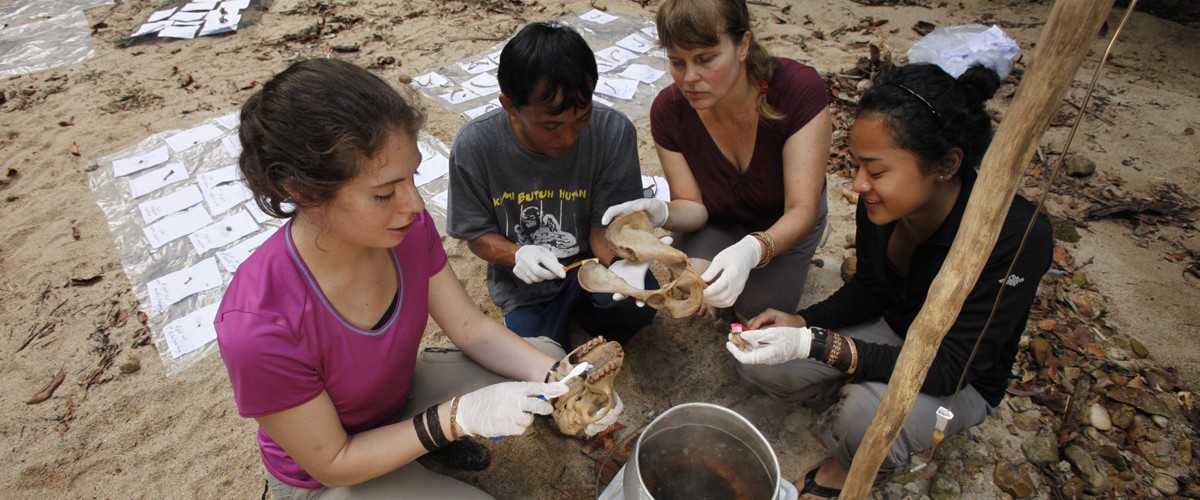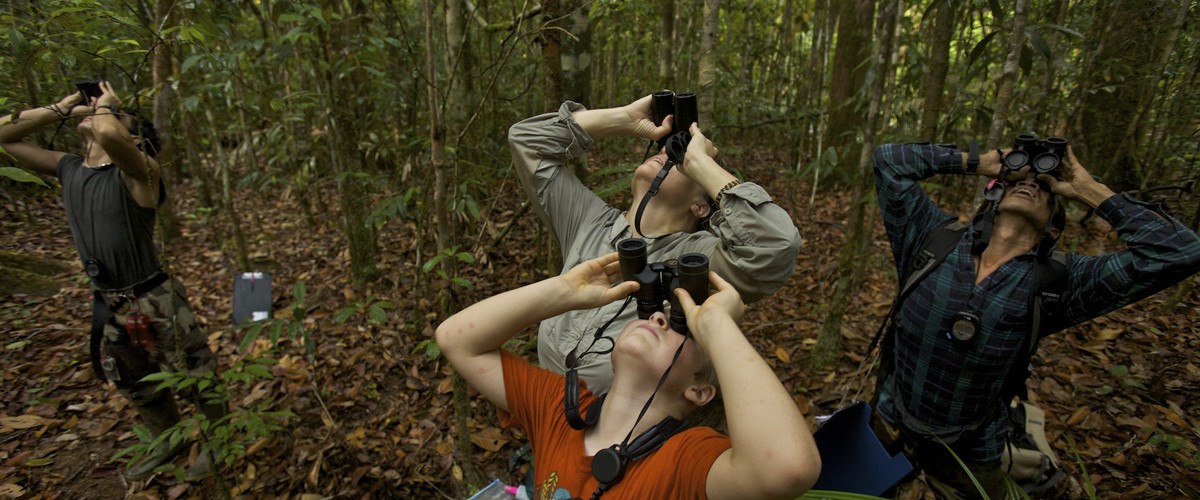“She asked if you are interested in learning English,” I said in Bahasa, shifting slightly on the mossy log beneath me.
“Tell her I know four different local languages,” Sahril said with a proud smirk.
I turned back towards the original speaker, a visiting Boston University graduate student researcher named Faye Harwell, to relay the words in English. The three of us sat huddled among crumbling logs and fallen vines as the sun began rising through the treetops and dawn changed to a bright sunny morning.
|
|
|
Akau, Faye, Becky, and Sahril drenched from the hike back to camp in the pouring rain. Photo © Faye Harwell.
|
Another field assistant, Akau, perched nearby a few trees behind us, fusses over the assembly of our orangutan urine collection apparatus. We were all waiting for orangutans, Bibi, and her baby, Bayas, who are still sleeping in a nest some 15 meters above us, to wake up. Twelve hours later, after wandering behind the mother and infant pair through dense forest far from camp all day, the four of us began the hike home just as the rain began crashing down. Wading down the mangled path, I realized with a smile that my very first follow, almost eleven months earlier, was with the very same companions: Indonesian and orangutan. Back on that day however, my thumbs were as tired as my feet from relentlessly flicking through a translating dictionary to understand the handful of words Sahril and Akau would politely utter to me. Now, however, not only were the three of us conversing and joking throughout the day, but I was acting as translator to someone else. Whereas before I sat in clueless wonderment, watching the men furiously enter data into the iPad, today they asked me questions and advice on the data to input.
This morning I pick up a fruit that the orangutans dropped and tell Faye its Latin name. Earlier this year, I could barely pronounce the names, much less identify the fruit myself. Although I knew my time with the project was coming to an end, I did not know it would actually be my last follow with the project or that Bibi and Bayas were the last of the Gunung Palung orangutans that I would watch in the wild. Unforeseen circumstances unfortunately pulled me from camp sooner than expected, and although I was greatly disappointed, I realize now how that really was the perfect end to my forest experiences as they came full circle.
|
|
|
Baby orangutan, Bayas, peering down at me during an afternoon follow. Photo © Becky Curtis.
|
As I counted down my last few weeks with the project, camp was at its busiest and liveliest of the entire year. Cheryl was here on her annual visit alongside her children and graduate student, Faye. Her husband, Tim Laman, was also at camp amongst a team from the BBC as they filmed orangutans for an upcoming documentary. This family, plus the new addition of a third project to camp and the researchers involved, meant that for the month of August Cabang Panti burst into a hive of activity. Several orangutans were followed daily and data poured into the lab where assistants, Syai and Rinta, stood poised at the ready with gloves and masks as endless fecal, urine and food samples were thrown their way for processing. They juggled and dove into the workload, as did Brodie, the Research Manager, in overseeing data processing alongside Cheryl.
|
Becky, Brodie, Cheryl, and Rinta going over data. Photo © Faye Harwell.
|
After so many months with the project, but never having met Cheryl in person, it was refreshing and enlightening to have the founding lady herself by our side. We spent many a morning all huddled on the floor around a single laptop, identifying fruit species and analyzing behavioral data. As well as busy work days, evenings were filled with entertainment, particularly with music thanks to Cheryl’s daughter, Jessica, and her guitar. The bright blue instrument was passed throughout camp and Indonesian and English songs alike were regularly sung late into the evening. We also had a particular boom in the number of women at the research station, bringing a sense of femininity to the camp that is usually a little weak! Daily Yoga sessions took place on the beach while baking, bracelet making and Zumba occurred in camp. One eventful evening we had a party of henna drawing, with many of us sitting huddled closely together on a bedroom floor. I feel lucky that I have seen almost every angle of camp possible, from a work aspect as well as social. I’ve seen camp with two people and with thirty, with only Indonesians (other than myself) and with a rainbow of nationalities.
|
|
|
From left to right, Syai, Becky, Brodie, and Rinta, going over lab samples. Photo © GPOCP.
|
Over the course of this year, I have learnt as much about people as I have about orangutans. The lessons and knowledge I have gained from this experience, culturally and socially as well as professionally, is truly unforgettable. I not only know how to record and analyze the feeding and digestion rates of an orangutan, but I also know how to make a meansambal, how to turn on a generator and I can sing along to a couple of Indo-pop songs (okay, attempt to). I will always be grateful to all my companions at camp for these memories and so much more. My gratitude, of course, extends to Cheryl and Brodie and to Terri and Wahyu, for their help throughout the year and on all problems outside the forest! My final thanks I would like to direct is to two very special and hard-working young people who are brand new to the project and whose future I believe to be very bright, Syai and Rinta, the lab assistants. I believe they are the representation of the conservation movement within the young generation of Indonesias. They not only helped me become a better leader, they also helped with my language skills and kept me smiling through the busiest of times. Alongside all the passionate staff of Gunung Palung National Park and GPOCP, they both gave me a renewed faith and comfort for the future, of not only our project, but for orangutans and Indonesian wildlife overall. What a year it has been, with so many stories created. Thanks to every human, orangutan, tree and all other critters of the forest for being part of it…minus mosquitoes and tropical diseases that is!














